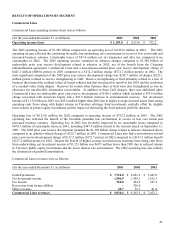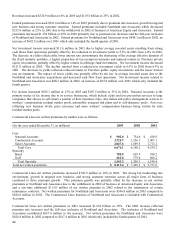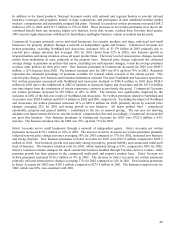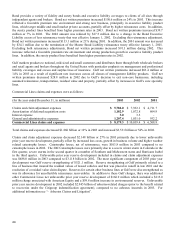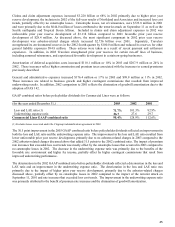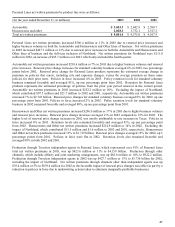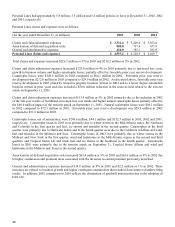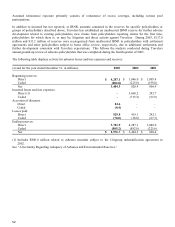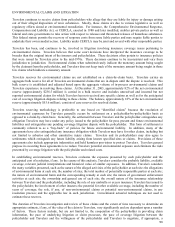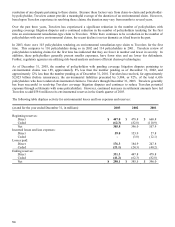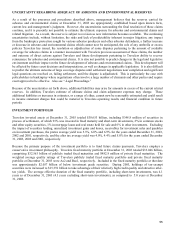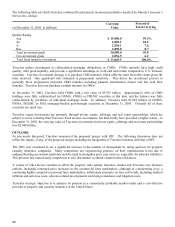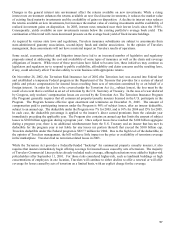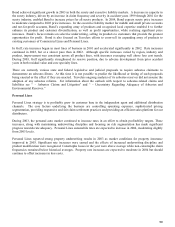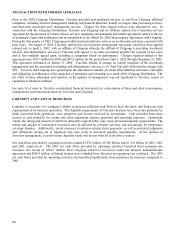Travelers 2003 Annual Report Download - page 52
Download and view the complete annual report
Please find page 52 of the 2003 Travelers annual report below. You can navigate through the pages in the report by either clicking on the pages listed below, or by using the keyword search tool below to find specific information within the annual report.50
ASBESTOS CLAIMS AND LITIGATION
Travelers believes that the property and casualty insurance industry has suffered from court decisions and other trends
that have attempted to expand insurance coverage for asbestos claims, far beyond the intent of insurers and
policyholders. As a result, Travelers continues to experience an increase in the number of asbestos claims being
tendered to Travelers by Travelers policyholders (which includes others seeking coverage under a policy) including
claims against Travelers policyholders by individuals who do not appear to be impaired by asbestos exposure. Factors
underlying these increases include more intensive advertising by lawyers seeking asbestos claimants, the increasing
focus by plaintiffs on new and previously peripheral defendants and entities seeking bankruptcy protection as a result
of asbestos-related liabilities. In addition to contributing to the increase in claims, bankruptcy proceedings may
increase the volatility of asbestos-related losses by initially delaying the reporting of claims and later by significantly
accelerating and increasing loss payments by insurers, including Travelers. Travelers is currently involved in coverage
litigation concerning a number of policyholders who have filed for bankruptcy, including, among others, ACandS,
Inc., who in some instances, have asserted that all or a portion of their asbestos-related claims are not subject to
aggregate limits on coverage as described generally in the next paragraph. (Also see “-Legal Proceedings.”)
Particularly during the last few months of 2001 and continuing through 2002, the trends described above both
accelerated and became more apparent. As expected, these trends continued into 2003. As a result of the trends
described above, there is a high degree of uncertainty with respect to future exposure from asbestos claims.
In some instances, policyholders continue to assert that their claims for asbestos-related insurance are not subject to
aggregate limits on coverage and that each individual bodily injury claim should be treated as a separate occurrence
under the policy. It is difficult to predict whether these policyholders will be successful on both issues or whether
Travelers will be successful in asserting additional defenses. To the extent both issues are resolved in policyholders’
favor and other additional Travelers defenses are not successful, Travelers coverage obligations under the policies at
issue would be materially increased and bounded only by the applicable per occurrence limits and the number of
asbestos bodily injury claims against the policyholders. Accordingly, it is difficult to predict the ultimate size of the
claims for coverage not subject to aggregate limits.
Many coverage disputes with policyholders are only resolved through settlement agreements. Because many
policyholders make exaggerated demands, it is difficult to predict the outcome of settlement negotiations. Settlements
involving bankrupt policyholders may include extensive releases which are favorable to Travelers but which could
result in settlements for larger amounts than originally anticipated. As in the past, Travelers will continue to pursue
settlement opportunities.
In addition, proceedings have been launched directly against insurers, including Travelers, challenging insurers’
conduct in respect of asbestos claims, including in some cases with respect to previous settlements. Travelers
anticipates the filing of other direct actions against insurers, including Travelers, in the future. Particularly in light of
jurisdictional issues, it is difficult to predict the outcome of these proceedings, including whether the plaintiffs will be
able to sustain these actions against insurers based on novel legal theories of liability. (Also see “-Legal
Proceedings.”)
Because each policyholder presents different liability and coverage issues, Travelers generally evaluates the exposure
presented by each policyholder on a policyholder-by-policyholder basis. In the course of this evaluation, Travelers
considers: available insurance coverage, including the role of any umbrella or excess insurance Travelers has issued to
the policyholder; limits and deductibles; an analysis of each policyholder’s potential liability; the jurisdictions
involved; past and anticipated future claim activity and loss development on pending claims; past settlement values of
similar claims; allocated claim adjustment expense; potential role of other insurance; the role, if any, of non-asbestos
claims or potential non-asbestos claims in any resolution process; and applicable coverage defenses or determinations,
if any, including the determination as to whether or not an asbestos claim is a products/completed operation claim
subject to an aggregate limit and the available coverage, if any, for that claim. When the gross ultimate exposure for
indemnity and related claim adjustment expense is determined for a policyholder, Travelers calculates, by each policy
year, a ceded reinsurance projection based on any applicable facultative and treaty reinsurance, as well as past ceded
experience. Adjustments to the ceded projections also occur due to actual ceded claim experience and reinsurance
collections. Conventional actuarial methods are not utilized to establish asbestos reserves. Travelers evaluations have
not resulted in any data from which a meaningful average asbestos defense or indemnity payment may be determined.



